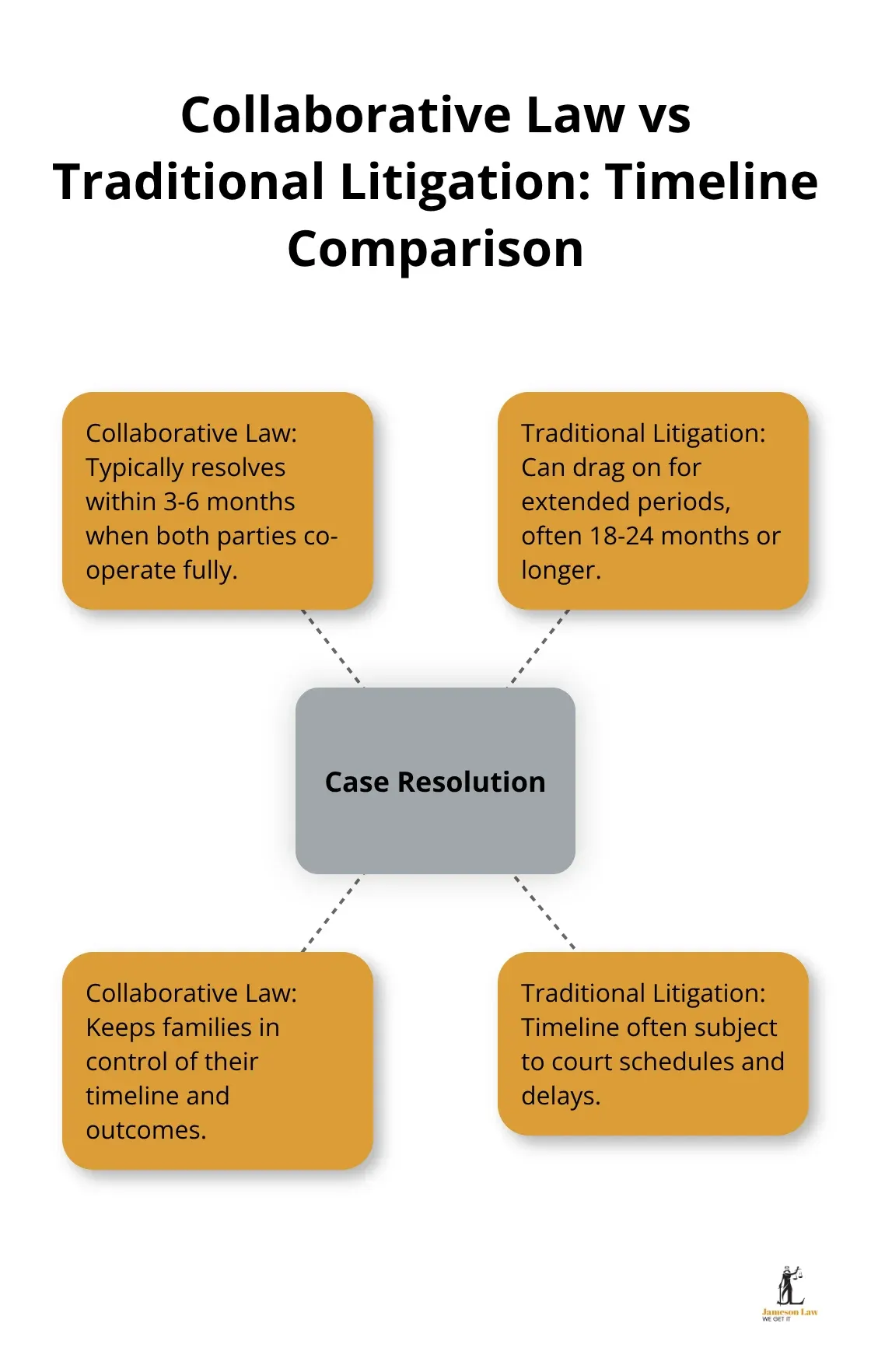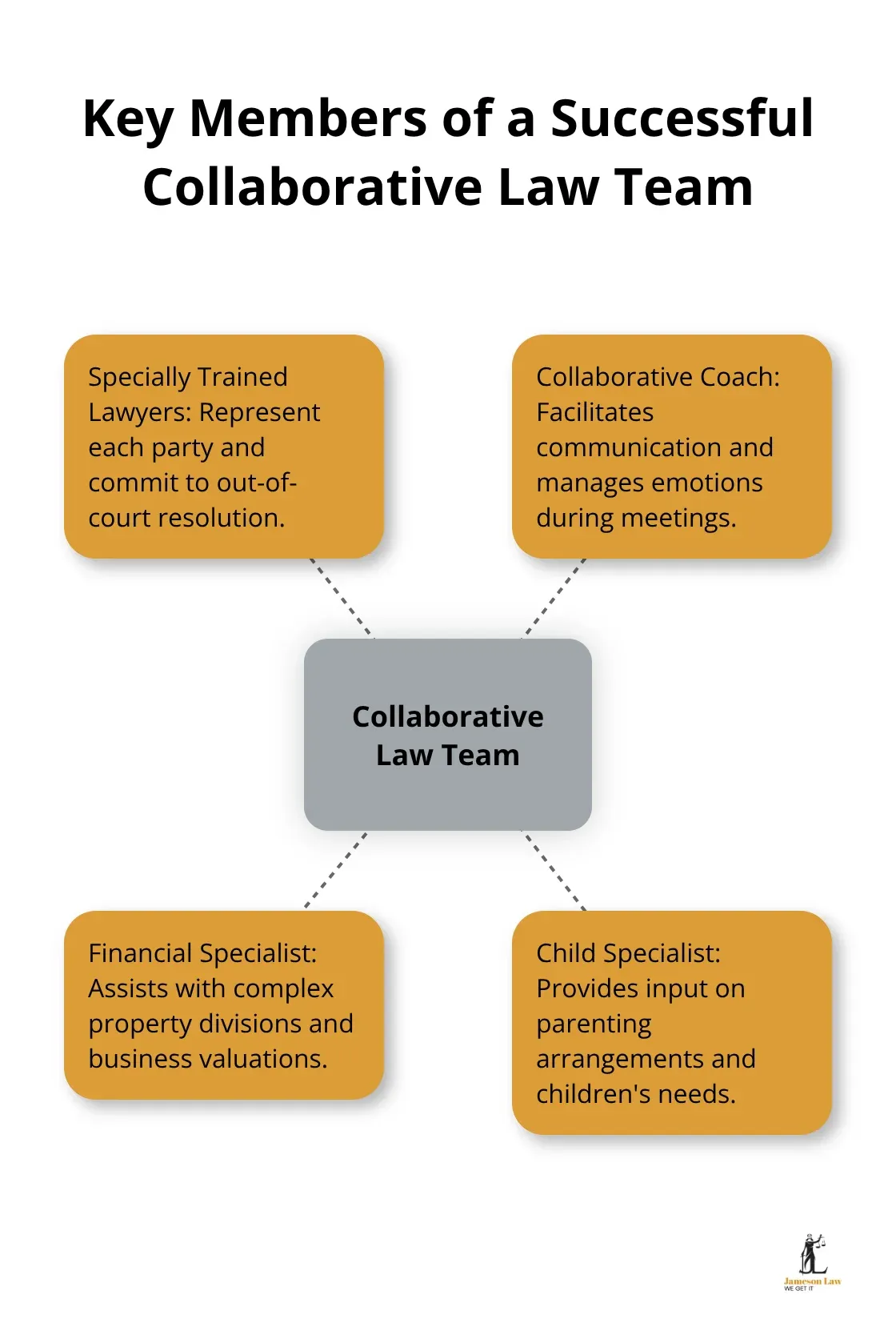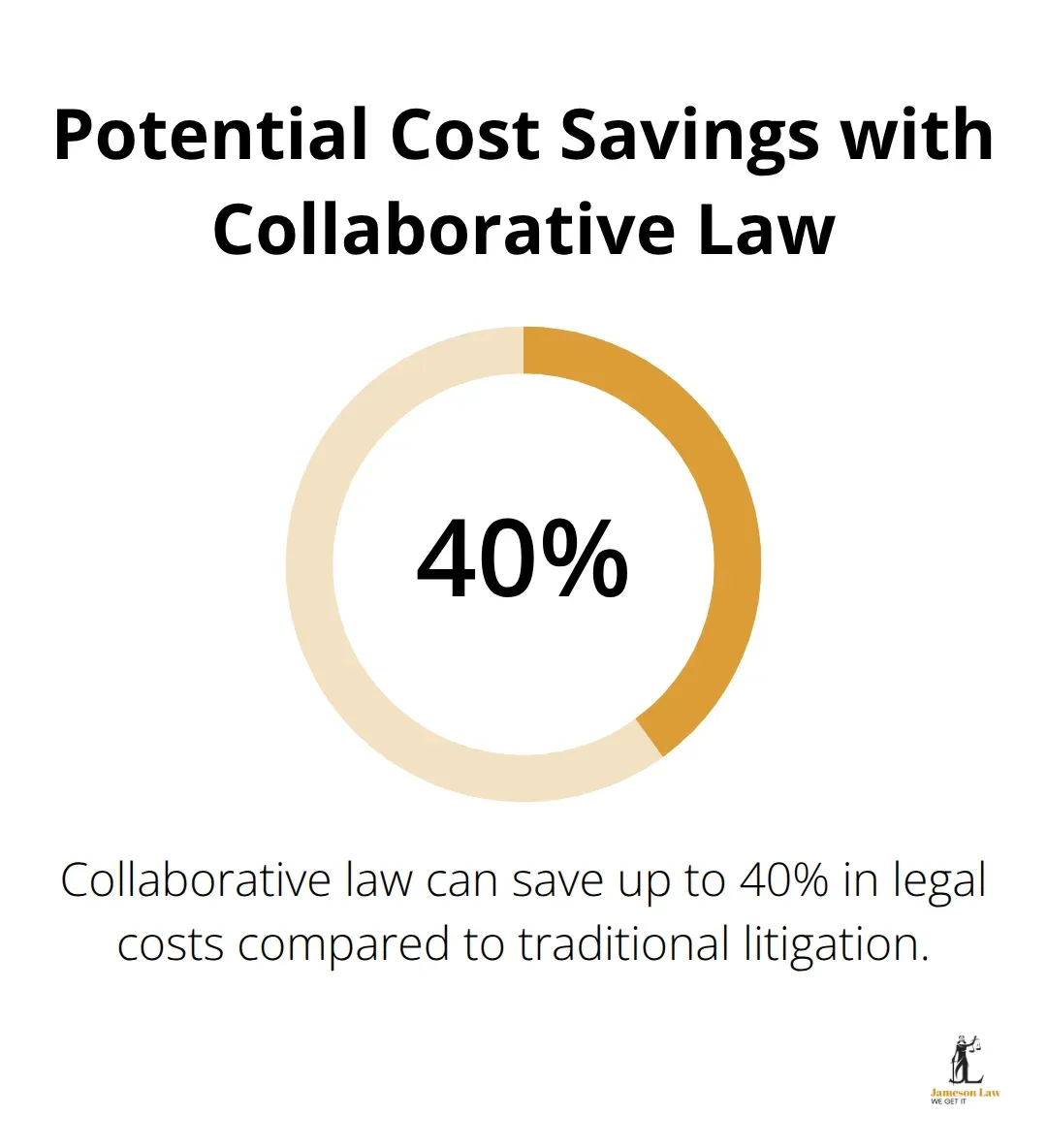Family disputes don’t have to end in bitter courtroom battles. Collaborative family law offers a respectful alternative that keeps families out of court while working toward mutually beneficial solutions.
We at Jameson Law have seen how this process transforms difficult situations into manageable conversations. This approach prioritises co-operation over conflict, helping families move forward with dignity intact.
What Makes Collaborative Family Law Different
Collaborative family law operates through a structured process where both parties and their lawyers sign a Participation Agreement that commits them to resolve disputes without court threats. This contract means if either party starts litigation, both collaborative lawyers must withdraw from the case entirely. The process typically involves four to seven structured meetings where couples work with their specially trained lawyers to negotiate settlements that prioritise family needs over adversarial tactics.
How the Collaborative Process Actually Works
Each party must hire a lawyer with at least five years of family law experience and specific collaborative training. The process begins when both parties sign the Participation Agreement, which establishes ground rules and confidentiality protections. A collaborative coach often facilitates five-way meetings that include both parties and their lawyers, which streamlines communication and keeps discussions productive. Documents that parties exchange during this process remain legally privileged and cannot be used in court if negotiations fail (this creates a safe space for honest disclosure).
Why Collaborative Law Beats Traditional Litigation
Traditional court proceedings in Australia can drag on for extended periods, while collaborative cases typically resolve within three to six months when both parties co-operate fully. Clients maintain complete control over their family issues and financial arrangements rather than have solutions imposed by a judge. Research shows that collaborative law participants report significantly higher satisfaction rates compared to those who went through traditional litigation. Court delays cost families both financially and emotionally, while collaborative law keeps families in control of their timeline and outcomes.

When Collaborative Law Works Best
Collaborative law succeeds when both parties genuinely want respectful resolutions and prioritise their children’s wellbeing over victory at all costs. This approach works exceptionally well for couples who need to maintain relationships as co-parents or business partners after separation (particularly important for Australian families with shared parenting and child support arrangements). However, collaborative law fails when one party seeks revenge or aims to undermine their partner’s interests. Cases that involve family violence require specialist assessment to determine if collaborative approaches can adequately protect all parties involved.
The success of collaborative law depends heavily on the right team assembly and clear communication protocols from the very first meeting.
How Does the Collaborative Process Actually Start
The collaborative process begins when both parties independently hire specially trained lawyers who have completed specialised collaborative training through organisations like the Australian Association of Collaborative Professionals. These lawyers must meet minimum practice requirements for collaborative practitioners and maintain ongoing professional development in collaborative methods. The first joint meeting involves the Participation Agreement, which establishes the framework for all future interactions and commits everyone to out-of-court resolution.
Team Assembly for Success
Most successful collaborative cases involve a collaborative coach who facilitates communication between all parties during structured meetings. The coach manages emotions and keeps discussions focused on practical solutions rather than past grievances. Financial specialists join the team when complex property divisions or business valuations require attention, while child specialists provide input on parenting arrangements. Research shows that cases with properly assembled teams resolve more efficiently than those without neutral professionals.

Communication Rules That Work
Ground rules established in the first meeting prohibit personal attacks, interruptions, and discussions outside the formal meeting structure without lawyer involvement. All communication happens through scheduled meetings with agendas prepared in advance (this prevents spontaneous arguments that derail progress). Transparency requirements mean both parties must provide complete financial disclosure as part of their duty to give all relevant financial information and documents to each other. The process includes regular check-ins between meetings to address procedural questions, but substantive negotiations only occur during formal sessions with all team members present.
From Problems to Solutions
The structured meeting format typically follows a pattern: identify issues, explore underlying interests, generate options, and evaluate solutions against agreed criteria. Each meeting has specific objectives, with most cases requiring four to seven sessions spaced two to three weeks apart. Progress depends on both parties who complete homework assignments between meetings (such as gathering financial documents or considering proposed arrangements). The collaborative coach tracks commitments made during each session and follows up on completion at subsequent meetings.
The structured approach creates momentum, but families often wonder about the real benefits and potential challenges they might face throughout this process.
What Are the Real Benefits and Drawbacks
Financial Impact and Timeline Advantages
Collaborative family law delivers measurable cost savings compared to traditional court proceedings. Contested family law matters cost an average of $25,000 per party, with complex cases reaching $100,000, while collaborative cases typically cost $15,000 to $25,000 per party according to Australian Association of Collaborative Professionals data. The time difference proves even more dramatic – court proceedings stretch 18 to 24 months on average, while collaborative cases resolve within three to six months when both parties commit fully.

Monthly bills in collaborative law provide complete transparency, as most work happens during structured meetings rather than behind-the-scenes preparation that inflates traditional legal costs. Clients see exactly what they pay for since lawyers conduct the majority of work during scheduled sessions with all parties present.
Privacy Protection and Stress Reduction
The collaborative process maintains complete confidentiality through legal privilege protections that prevent any discussions from appearing in court records if negotiations fail. This privacy shield allows parties to discuss sensitive financial information and personal matters without fear of public exposure (particularly important for high-profile individuals or business owners).
Emotional stress drops significantly because the process eliminates adversarial tactics and courtroom confrontations that damage family relationships permanently. Research demonstrates that collaborative participants report higher satisfaction rates compared to traditional litigation participants, primarily due to reduced conflict and maintained dignity throughout the process.
Power Imbalances and Safety Concerns
Collaborative law becomes ineffective when power imbalances exist between parties, particularly in domestic violence situations where one party cannot negotiate safely. Cases that involve severe mental health issues, substance abuse, or personality disorders often require court intervention rather than collaborative approaches. Specialists must assess whether collaborative methods can adequately protect all parties before proceeding with this approach.
Complex Cases That Need Court Expertise
The process also fails when one party refuses to provide complete financial disclosure or uses collaborative meetings to gather information for future litigation. International custody disputes or complex business valuations often require court expertise that collaborative teams cannot provide effectively. High-conflict personalities who seek revenge rather than resolution will undermine the collaborative process from the start.
Final Thoughts
Collaborative family law transforms how Australian families approach separation by prioritising co-operation over conflict. The process delivers tangible benefits including cost savings of up to 40% compared to traditional litigation, resolution timeframes of three to six months rather than years, and complete privacy protection through legal privilege. Success depends on three essential factors: both parties must genuinely commit to respectful resolution, complete transparency in financial disclosure, and willingness to prioritise children’s wellbeing over personal grievances.
The structured meeting format with specially trained lawyers creates accountability that keeps negotiations productive. However, collaborative approaches fail when power imbalances exist, domestic violence concerns arise, or one party seeks revenge rather than resolution. Complex international custody matters or severe mental health issues often require court intervention instead (particularly when safety concerns override co-operative approaches).
The decision to pursue collaborative family law requires careful assessment of your specific circumstances and relationship dynamics. We at Jameson Law can evaluate whether collaborative approaches suit your needs or if alternative dispute resolution methods would better serve your family’s interests. Our experienced family law team provides professional guidance to help families choose the most effective path forward while protecting their rights throughout the process.













